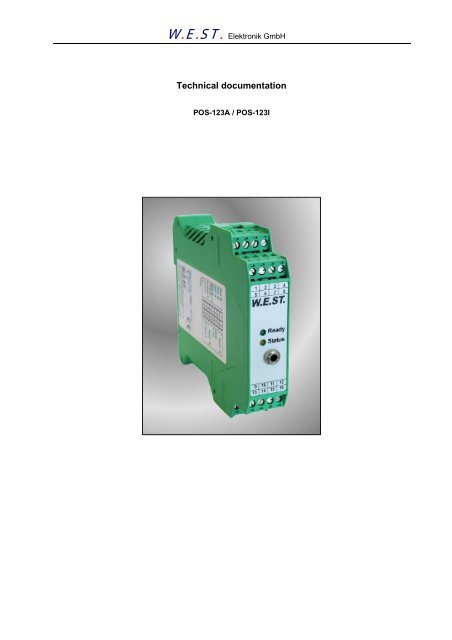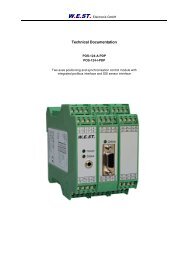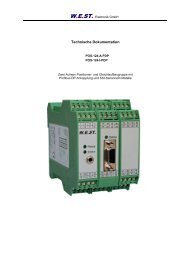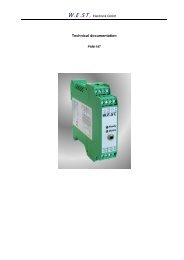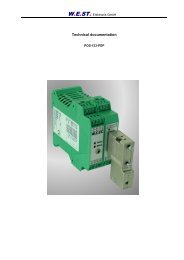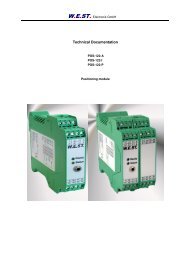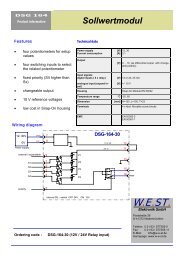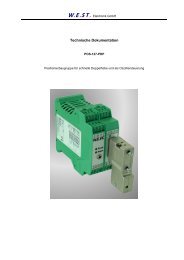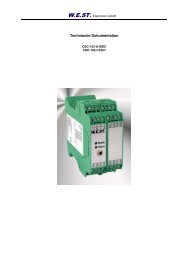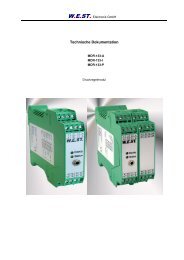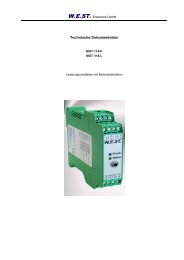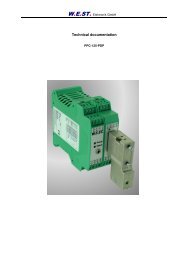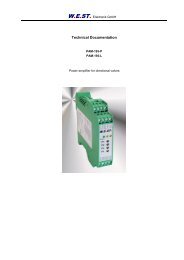Technical documentation
Technical documentation
Technical documentation
Create successful ePaper yourself
Turn your PDF publications into a flip-book with our unique Google optimized e-Paper software.
W.E.ST. Elektronik GmbH<br />
<strong>Technical</strong> <strong>documentation</strong><br />
POS-123A / POS-123I
W.E.ST. Elektronik GmbH<br />
Table of contents<br />
Revisions ...................................................................................................................................................... 3<br />
Ordering code ............................................................................................................................................... 3<br />
Accessories .................................................................................................................................................. 3<br />
General description....................................................................................................................................... 4<br />
General installation remarks......................................................................................................................... 5<br />
Description of the unit................................................................................................................................... 6<br />
Typical positioning ............................................................................................................................. 6<br />
In- and outputs ..................................................................................................................................... 7<br />
LED Function ....................................................................................................................................... 7<br />
Block diagram ...................................................................................................................................... 8<br />
Typical wiring ....................................................................................................................................... 9<br />
<strong>Technical</strong> Data ................................................................................................................................... 10<br />
Dimensions ...................................................................................................................................... 10<br />
General IO description ....................................................................................................................... 11<br />
Power supply ................................................................................................................................... 11<br />
Digital inputs .................................................................................................................................... 11<br />
Digital outputs .................................................................................................................................. 11<br />
Analogue inputs ............................................................................................................................... 12<br />
Analogue outputs............................................................................................................................. 12<br />
Serial interface................................................................................................................................. 13<br />
Start-up and commissioning guidelines...................................................................................................... 14<br />
Parameter table .......................................................................................................................................... 15<br />
Parameter description................................................................................................................................. 16<br />
AIN (input signal scaling) ................................................................................................................. 16<br />
A (acceleration time)........................................................................................................................ 16<br />
D (deceleration stroke or braking distance).....................................................................................17<br />
CTRL (braking characteristics) ........................................................................................................ 17<br />
VELO (Internal velocity preset)........................................................................................................ 18<br />
VS (internal or external velocity preset)........................................................................................... 18<br />
VRAMP (ramp time for the external velocity) .................................................................................. 18<br />
VMODE (Activation of the NC mode) .............................................................................................. 18<br />
TH (Stroke time for the speed controlled axis) ................................................................................ 19<br />
HAND (Hand speed)........................................................................................................................ 19<br />
MIN (compensation of the dead zone) ............................................................................................ 20<br />
MAX (maximum output signal)......................................................................................................... 20<br />
TRIGGER (threshold value of MIN)................................................................................................. 20<br />
INPOS (in positioning window) ........................................................................................................ 21<br />
OFFSET (zero point adjustment)..................................................................................................... 21<br />
POL (output polarity)........................................................................................................................ 21<br />
SENS (sensor monitoring) ............................................................................................................... 21<br />
SAVE (data storing in EEPROM)..................................................................................................... 21<br />
LOADBACK (copy of the EEPROM into the active RAM) ............................................................... 22<br />
DEFAULT (parameter reset)............................................................................................................ 22<br />
PROCESS DATA (monitoring) ........................................................................................................ 22<br />
Appendix: Power stage (PEXT3)................................................................................................................ 23<br />
Remarks ..................................................................................................................................................... 24<br />
Seite 2 von 24
Revisions<br />
W.E.ST. Elektronik GmbH<br />
Date Module revision Comment<br />
14.02.2006 1113 rev 1 New hardware based on the ME5 board.<br />
27.04.2007 1113 rev 2 Software adaptation of the 4… 20 mA output<br />
14.05.2008 1113 rev 3<br />
Ordering code<br />
POS-123A-11* - with analogue ± 10 V output<br />
POS-123I-11* - with analogue 4… 20 mA output<br />
The working direction of the sensor signal is changeable.<br />
AIN:X -1000 1000 10000 V or AIN:X -1250 1000 10000 C<br />
will invert the working range.<br />
Optional<br />
POS-123P - with integrated power stage<br />
POS-123PDP - with integrated Profibus PD and SSI sensor interface (see doc. POS-123PDP)<br />
* = Version number, for ordering not necessary. Changes of the last digit (13 to 14) indicate technical improvements<br />
at 100% compatibility. Changes from 13 to 20 indicate significant technical improvements. In<br />
this case check the <strong>documentation</strong> about the parameter and wiring.<br />
Accessories<br />
RS232-SO - programming cable with RS232C interface<br />
USB-SO - programming cable with USB interface<br />
HHT-302 - Hand held terminal<br />
WPC-300 - Start up software<br />
W.E.ST. Elektronik GmbH<br />
Poststraße 26<br />
D-41372 Niederkrüchten<br />
Fax.: +49 (0) 2163 57 73 55 - 11<br />
Homepage: www.w-e-st.de or www.west-electronics.com<br />
EMAIL: info@w-e-st.de<br />
Date: 14.04.2008<br />
Revision: 9<br />
The right of changes are reserved.<br />
Seite 3 von 24
General description<br />
W.E.ST. Elektronik GmbH<br />
This electronic module is developed for controlling of hydraulic positioning drives. A typical signal accuracy<br />
of app. 0,01% of the sensor stroke can be achieved. The sampling time of the control loop is 1ms.<br />
Proportional valves with integrated electronics or external power amplifiers can be controlled by the analogue<br />
differential output (or by the 4… 20 mA current output). Additionally an integrated power amplifier<br />
for best performance is available.<br />
Internal profile generation (acceleration time, max. velocity and stroke depended deceleration) provides<br />
fast and excellent positioning. Two modes can be selected.<br />
Stroke depended deceleration: The axis drives in open loop mode and is switched over in closed loop<br />
during deceleration. This is a time-optimal positioning structure with very high stability. The maximal velocity<br />
can be limited by the external velocity input.<br />
NC mode: An integrated NC profile generator (VMODE command) can be activated. The position profile<br />
is internally generated with defined speed and the axis is following (controlled by the following error) the<br />
command position with the same speed.<br />
Internal functions, InPos, out of stroke and sensor or command failure are monitored by the two digital<br />
outputs: ready and status.<br />
The adjustment via RS232C is simple and easy to understand. A standard terminal program or our special<br />
windows application software (WPC-300, download from our homepage) can be used.<br />
Typical applications: positioning drives, handling axis and fast transportable drives (adaptation of nonlinear<br />
valve characteristics).<br />
Features<br />
• Extern definable target positions<br />
• High speed positioning mode<br />
• Principle of stroke depended deceleration or NC controlled movement<br />
(speed controlled)<br />
• Optimal use of overlapped and zero overlapped proportional valves<br />
• Internal profile, defined by acceleration time, max velocity and deceleration<br />
stroke<br />
• Extern definable velocities<br />
• Simple and application orientated parameter settings<br />
• Failure monitoring<br />
• Adjustments via RS232C interface<br />
Seite 4 von 24
General installation remarks<br />
Explanation of terms and notes on safety<br />
Terms:<br />
w: command signal<br />
x: actual signal<br />
v external speed<br />
xw: error between w and x (x- w)<br />
u: output signal<br />
W.E.ST. Elektronik GmbH<br />
Mounting instructions<br />
This module is for the installation provided in shielded electromagnetic compatibility housing (EMC conform).<br />
All cables operating outside have to be screened. A complete shielding is presupposed. By use of our<br />
control modules it is also presupposed, that no strong electrical disturbances near the module are installed.<br />
Typical mounting area: 24V control signal area (near PLC)<br />
By the arrangement of the electrical cabinet a separation between power part (and power cables) and<br />
signal part must be taken in consideration. Experience shows us that the area next to the PLC (24 V<br />
area) is suitable. All digital and analogue inputs and outputs have filters and an over voltage protection. In<br />
case of correct wiring and shielding all EMC demands are fulfilled. If there are nevertheless any problems,<br />
please send us detailed sketches of mounting and wiring. We will look after this problem immediately.<br />
Even if all EMC-norms are fulfilled, technical problems in special cases are possible. Our experience has<br />
shown us that most of these problems are caused in the physical conditions of the cables. If everything is<br />
shielded continuously and configured correctly, no problems have to be expected.<br />
ATTENTION!<br />
ATTENTION!<br />
Due to electrical disturbances, failure at components as well as software faults can cause<br />
in individual cases uncontrolled movements at the drive. Appropriate safety precautions<br />
have to be considered during the engineering.<br />
Connection and start up of the module may only be allowed by qualified persons<br />
who have, because of education, experience and instruction, sufficient<br />
acknowledge on relevant directives and approved technical rules. Please<br />
read and follow the operating instructions carefully. In case of non observance<br />
of the instruction the guaranty and liability claim expires.<br />
Seite 5 von 24
Description of the unit<br />
Typical positioning<br />
W.E.ST. Elektronik GmbH<br />
This module supports the simple point-to-point positioning with hydraulic drives. The system works with<br />
the principle of stroke depended deceleration, that means the control gain will be adjusted with the parameters<br />
D:A and D:B.<br />
The deceleration characteristics can be defined with the parameter CTRL linear (LIN) or nearly square<br />
root (SQRT1). By use of standard proportional valves, SQRT1 has to be chosen normally.<br />
By use of control valves with linear characteristics, it depends on the application. If you choice LIN, a<br />
shorter deceleration stroke can be set (D:A and D:B).<br />
Sequence of the positioning:<br />
The positioning process will be controlled by switching inputs. After enabling (ENABLE input), the command<br />
position is set to the actual position of the sensor and the axis is in closed loop position control<br />
mode. The READY output indicates a general ready for operation. With START input, the analogue<br />
command input (Pin 13) is active and new command positions will be taken over. The axis is immediately<br />
driving to this new position and indicates, with the InPos output, when the axis is in position. The InPos<br />
output is active as long as the axis is within the InPos window or the START input is active.<br />
The axis can be driven in manual mode (START is off) with the digital inputs HAND+ or HAND-. The programmed<br />
velocity (parameter HAND) is used.<br />
When the HAND inputs are switched off, the command position is set to the actual position and the system<br />
is in closed loop position control mode.<br />
Weak points of positioning accuracy:<br />
The positioning accuracy will almost be limited by the hydraulics and mechanics. Therefore, the correct<br />
valve selection is the most important point. Additionally, two contradictory requirements (short positioning<br />
time and high accuracy) have to be considered in the system design.<br />
v+<br />
v-<br />
MAX:A<br />
A:A D:A<br />
D:B<br />
Volumenstrom P-A und B-T<br />
Regelrichtung<br />
Ausfahren<br />
Regelrichtung<br />
Einfahren<br />
MAX:B<br />
Seite 6 von 24<br />
A:B
In- and outputs<br />
W.E.ST. Elektronik GmbH<br />
Terminal Description of the analogue inputs and outputs<br />
PIN 9/10 External command speed (V), range 0… 100 % corresponds to 0… 10 V<br />
PIN 6 -<br />
PIN 13 Command position (W), range 0… 100% corresponds to 0… 10V or 4… 20 mA<br />
PIN 14 Actual (feedback) value (X), range 0… 100% corresponds to 0… 10V or<br />
4… 20 mA<br />
PIN 15 / 16 Differential output (U) ± 100% corresponds to ± 10V differential voltage,<br />
optionally (I-version) current output ±100% corresponds to 4… 20 mA (PIN 15 to<br />
PIN 11)<br />
Terminal Description of the digital inputs and outputs<br />
PIN 8 Enable input:<br />
This digital input signal initializes the application. The analogue output is active<br />
and the READY signal indicates that all components are working correctly. Target<br />
position is set to actual position and the drive is closed loop controlled.<br />
PIN 7 START (RUN) input:<br />
The positioning controller is active; the external analogue command position is<br />
taken over as command value. If the input is switched off during movement the<br />
command position is set to the actual position plus a defined emergency deceleration<br />
stroke<br />
PIN 6 HAND+ input:<br />
Hand mode (START = OFF), driving with the programmed velocity. After deactivation<br />
the actual value is taken over as command position.<br />
PIN 5 HAND- input:<br />
Hand mode (START = OFF), driving with the programmed velocity. After deactivation<br />
the actual value is taken over as command position.<br />
PIN 2 STATUS output:<br />
Monitoring of the control error (INPOS). Depending on the INPOS command, the<br />
status output will be deactivated, if the position difference is greater then the adjusted<br />
window.<br />
The output is only active if START = ON.<br />
PIN 1 READY output:<br />
General operationality, ENABLE is active and there is no sensor error (by use of<br />
4… 20 mA sensors). This output corresponds with the green LED.<br />
LED Function<br />
LEDs Description of the LED function<br />
GREEN Identical with the READY output.<br />
OFF: No power or ENABLE is inactive.<br />
ON: System in process<br />
FLASHING Failure detected (internal or 4… 20 mA).<br />
Only if SENS = ON.<br />
YELLOW Identical with the STATUS output.<br />
OFF: Control error depending of the error parameter.<br />
ON: No control error.<br />
Seite 7 von 24
Block diagram<br />
POS-123<br />
3,5 mm JISC-6560<br />
Ramp time<br />
24V<br />
3<br />
24 V<br />
DC<br />
10<br />
9<br />
0..10V<br />
command speed<br />
4<br />
0 V<br />
RS232 C<br />
9600 Baud<br />
1 Stopbit<br />
no parity<br />
V<br />
vramp x <br />
x = 1...2000<br />
0V<br />
DC<br />
0 V<br />
0 V<br />
11<br />
Power supply<br />
W.E.ST. Elektronik GmbH<br />
Differential input<br />
of the actuator<br />
Acceleration A<br />
Deceleration A<br />
Input selector<br />
13<br />
15<br />
Output: A (0..10)V<br />
a:i x <br />
i = A<br />
x = 1...2000 ms<br />
d:i x <br />
i = A<br />
x = 10...10000<br />
ain:i a b c x <br />
i = W<br />
0..10V<br />
4..20mA<br />
Command<br />
position<br />
16<br />
a,b,c = -10000...10000<br />
x = V|C<br />
11<br />
0 V<br />
0 V<br />
Output: B (0..10)V<br />
a:i x <br />
i = B<br />
x = 1...2000 ms<br />
d:i x <br />
i = B<br />
x = 10...10000<br />
14<br />
12<br />
Valve adaptation<br />
vs x <br />
x = EXT | INT<br />
velo x <br />
x = 1000...10000<br />
min:i x <br />
i = A|B<br />
x = 0..5000<br />
max:i x <br />
i = A|B<br />
x = 5000..10000<br />
trigger x <br />
x = 0..2000<br />
pol x <br />
x = +|-<br />
offset x <br />
x = -2000... 2000<br />
XW<br />
W<br />
U<br />
Input selector<br />
X<br />
ain:i a b c x <br />
i = X<br />
0..10V<br />
4..20mA<br />
Feedback<br />
position<br />
Acceleration B<br />
Deceleration B<br />
a,b,c = -10000...10000<br />
x = V|C<br />
11<br />
Seite 8 von 24<br />
I version: 4... 20 mA output<br />
PIN 15 to PIN 12<br />
0 V<br />
0 V<br />
Ready<br />
1<br />
24 V output<br />
Control program<br />
24 V input<br />
8<br />
Enable<br />
InPos<br />
2<br />
24 V output<br />
24 V input<br />
7<br />
Start<br />
PE via DIN-RAIL<br />
SUPPORT DIAGNOSTICS CONFIGURATION<br />
save din inpos x (x = 0..2000)<br />
loadback x ctrl x (x = LIN|SQRT1|SQRT2)<br />
help w sens x (x = ON|OFF)<br />
para xw hand:i x (i = A|B, x = -10000..10000)<br />
default u vmode x (x = ON|OFF)<br />
v th x (x = 100...60000)<br />
24 V input<br />
6<br />
Hand +<br />
24 V input<br />
5<br />
Hand -
Typical wiring<br />
PLC Inputs<br />
PLC Outputs<br />
analogue command<br />
signal from PLC<br />
Error / InPos<br />
Ready<br />
Enable<br />
Start<br />
Hand+<br />
Hand-<br />
Actual position<br />
0..10V<br />
W.E.ST. Elektronik GmbH<br />
PE terminal<br />
1<br />
5<br />
9<br />
13<br />
0..10V<br />
0V<br />
2<br />
6<br />
10<br />
14<br />
3<br />
7<br />
11<br />
15<br />
4<br />
8<br />
12<br />
16<br />
Seite 9 von 24<br />
PE terminal<br />
0V<br />
0..10V<br />
0..10V<br />
Screen<br />
24V<br />
0V<br />
Power supply<br />
To the power amplifier or valve<br />
with integrated electronics.<br />
Differential input is required.<br />
(-10V..10V)<br />
4... 20 mA output:<br />
PIN 15 to PIN 12
<strong>Technical</strong> Data<br />
Power supply<br />
Current consumption<br />
External fuse<br />
Dimensions<br />
WIDTH (see technical data)<br />
W.E.ST. Elektronik GmbH<br />
[VDC]<br />
[mA]<br />
[A]<br />
Digital inputs [V]<br />
[V]<br />
Digital outputs [V]<br />
[V]<br />
Analogue inputs (sensor and command<br />
signals)<br />
Resolution<br />
Speed input<br />
Resolution<br />
Analogue outputs<br />
Max. load<br />
Resolution<br />
[V]<br />
[mA]<br />
[%]<br />
[V]<br />
[%]<br />
[V]<br />
[mA]<br />
[mA]<br />
[%]<br />
Sample time ms 1<br />
Seite 10 von 24<br />
12… 30 (incl. ripple)<br />
12 V<br />
logic 0: < 2 V<br />
logic 1: > 12 V (50 mA)<br />
0...10; 33 kOhm<br />
4...20; 250 Ohm<br />
0,01 (internally 0,0031)<br />
0...10; 90 kOhm<br />
0,01<br />
2 x 0...10 (differential output)<br />
5<br />
4...20 mA (I version); 390 Ohm max. load<br />
0,024<br />
Interface RS 232C, 9600 Baud, 1 stopbit, No parity, Echo<br />
Mode<br />
Housing Snap-On Module EN 50022<br />
Polyamide PA 6.6<br />
Combustibility class V0 (UL94)<br />
Protection class<br />
Temperature range<br />
Humidity<br />
[IP]<br />
[°C]<br />
[%]<br />
Dimensions (width) [mm] 22,5<br />
20<br />
-20… 60<br />
W.E.ST. Elektronik GmbH<br />
General IO description<br />
This description is a general description of the technical data of out open loop and closed loop control<br />
modules. Please check the implemented IO signals via the block diagram about availability.<br />
Power supply<br />
This module is designed for 12… 30 VDC (typical 24 V) of a power supply. This power supply must correspond<br />
to the actual EMC standards.<br />
All inductivities at the same power supply (relays, valves …) must be provided with an over voltage protection<br />
(varistors, free-wheel diodes …).<br />
It is recommended to use a regulated power supply (linear or switching mode) for the supply of the module<br />
and the sensors. These power supplies have a clearly lower internal resistance in comparison with<br />
non regulated power supplies and therefore a better spurious rejection.<br />
Power supply : 12… 30 VDC, incl. ripple<br />
Power consumption: 100 mA<br />
External protection: 1 A medium lag<br />
ATTENTION: Without an external fuse and in case of a continual short-circuit the<br />
module can be destroyed in spite of all internal protections.<br />
Digital inputs<br />
The digital inputs are designed for a voltage level of 12 V and 24 V. The typical connections to the PLC<br />
will not be screened if the modules are arranged carefully and with short cable lengths. As common potential<br />
0V (PIN 4) is used.<br />
All inputs are protected with suppressor diodes and RC-filters against transient overshoots.<br />
Low level: < 4 V<br />
High level: > 12 V<br />
Current: < 0,1 mA<br />
Digital outputs<br />
The digital outputs are designed for a voltage level of 12 V and 24 V. The typical connections to the PLC<br />
will not be screened if the modules are arranged carefully and with short cable lengths. As common potential<br />
0V (PIN 4) is used.<br />
All outputs are protected with suppressor diodes and RC-filters against transient overshoots.<br />
Low level: < 4 V<br />
High level: > 10 V<br />
Current: max. 50 mA (with load of 200 Ohm)<br />
Seite 11 von 24
W.E.ST. Elektronik GmbH<br />
Analogue inputs<br />
By use of analogue inputs you have to distinguish between symmetrical and asymmetrical inputs.<br />
All analogue inputs must be screened.<br />
The symmetrical input is carried out as a differential input for voltage signals and can be switched over<br />
per software to bipolar or unipolar signals. Especially by use of high-resolution analogue signals an additional<br />
cable twisted in pairs has to be taken.<br />
The asymmetrical inputs are optimized for the two-pole-conductor techniques (voltages or current signals<br />
as usual in the automobile industry). They can be switched over by software between voltage and<br />
current input. A low-impedance GND connection is required for good signal transmission. In this configuration<br />
the return line is the GND of the power supply. Therefore sensors and the control module should be<br />
combined at a common star point (low impedance) with the GND of the power supply. As common potential<br />
the 0V PIN 11 and optionally PIN 12 are used.<br />
All inputs are protected with suppressor diodes and RC-filter against transient overshoots.<br />
Differential input:<br />
Voltage level: bipolar ±10 V (PIN 9 and PIN 10)<br />
unipolar 0… 10 V (PIN 10 against PIN 9)<br />
input resistance: > 91 kΩ<br />
Asymmetrical inputs:<br />
Voltage level: unipolar 0… 10 V (against PIN 11)<br />
input resistance: 25 kΩ<br />
Current level: unipolar 4… 20 mA (against PIN 11)<br />
input resistance: app. 250 Ω<br />
Analogue outputs<br />
The analogue outputs are carried out as symmetrical differential outputs. Because all power amplifiers<br />
have a differential input (especially valves with integrated electronics), an optimal signal transmission<br />
even over greater distances is possible. All analogue outputs have to be wired with screened cables.<br />
Ideally, twisted pair cables are used. For the signal potential or if both outputs are used as two separate<br />
asymmetrical signals (f. e. for plug amplifiers), PIN 12 as GND potential has to be used. All outputs are<br />
protected with suppressor diodes against transient overshoots.<br />
As differential output:<br />
Voltage level: bipolar ±10 V (PIN 15 and PIN 16)<br />
Output current: max. 10 mA<br />
As asymmetrical outputs:<br />
Voltage level: 2 x unipolar 0… 10 V (PIN 15 or PIN 16 against PIN 12)<br />
Output current: max. 10 mA<br />
Seite 12 von 24
W.E.ST. Elektronik GmbH<br />
As current output:<br />
Voltage level: 1 x unipolar 4… 20 mA (PIN 15 to PIN 12)<br />
max output current: max. 22 mA<br />
max load: 390 ohm<br />
ATTENTION! At the asymmetrical output with the 0 V potential at PIN 12 a minimal<br />
output voltage of approx 0,1 to 0,15 V exists.<br />
Serial interface<br />
The serial interface is chosen for the parametering with a PC or a notebook. A suitable cable of 3,5mm<br />
JISC-6560 plug to 9pol. RS232 (PC compatible) can be bought under RS232-SO.<br />
You can parameterize our modules with each terminal program. However, by use of our application software<br />
WPC-300 you have enlarged functions and therefore it is preferable.<br />
Download: WWW.WEST-ELECTRONICS.COM or WWW.W-E-ST.DE<br />
Features:<br />
• Table orientated parametering<br />
• Saving and loading of the parameter sets<br />
• Process data monitoring<br />
• Oscilloscope for dynamical optimization of the control parameters<br />
• Terminal window for flexible data input<br />
Seite 13 von 24
W.E.ST. Elektronik GmbH<br />
Start-up and commissioning guidelines<br />
1. The module must be mounted and wired with attentions to EMC requirements. A star orientated<br />
ground connection should be used when other power consumers are sharing the same power<br />
supply. Following points have to be taken in account for wiring:<br />
• Signal cable and power cable have to be wired separately.<br />
• Analogue signal cables must be screened.<br />
• Other cables should be screened in case of strong electrical disturbance (power relays,<br />
frequency controlled power driver) or at cable lengths > 3m. With high frequency EMI inexpensive<br />
ferrite elements can be used. In this typical configuration of installation (see<br />
point 2 to 4), no extra step should be taken in consideration.<br />
2. By the arrangement of the electrical cabinet a separation between the power part (and power cables)<br />
and signal part must be taken in consideration. Experience shows us that the area next to<br />
the PLC (24 V area) is suitable.<br />
3. Low impedance between PE “protected earth” and DIN-Rail should be used. Transient interference<br />
voltages at the terminals are discharged via DIN-Rail to the local PE. The screens have to<br />
be connected directly next to the module via PE terminals.<br />
4. The power supply should be carried out voltage regulated (i. e. PWM controlled). The low impedance<br />
of controlled power supplies facilitates improved interference damping. Therefore the signal<br />
resolution will be increased. Switched inductance (relays and solenoids) operating from the same<br />
power supply has to be damped by surge protection elements directly by the inductance.<br />
5. According to the motion diagram, the power amplifier- / valve- / drive combination should drive<br />
out with positive output signal (PIN 15 to PIN 16) and the output voltage of the sensor heightens.<br />
ATTENTION: This output is a differential output. Both outputs may not be<br />
connected with 0V.<br />
Seite 14 von 24
Parameter table<br />
W.E.ST. Elektronik GmbH<br />
Commands Parameter Defaults Units Description<br />
ain:i a b c x i= W|X<br />
a= -10000… 10000<br />
b= -10000… 10000<br />
c= -10000… 10000<br />
x= V|C<br />
a:i x i= A|B<br />
x= 1… 2000<br />
d:i x i= A|B<br />
x= 10… 10000<br />
ctrl x x= lin|sqrt1<br />
|sqrt2<br />
: 10000<br />
: 10000<br />
: 0<br />
: V<br />
:A 100<br />
:B 100<br />
:A 2500<br />
:B 2500<br />
-<br />
-<br />
0,01%<br />
-<br />
ms<br />
ms<br />
0,01%<br />
0,01%<br />
Seite 15 von 24<br />
Analogue output selection. W and X for the inputs and V = voltage,<br />
C = current. With the parameters a, b and c the inputs can be scaled<br />
(output = a / b * (input - c)).<br />
Because of the programming of the x-value (x = C) the corresponding<br />
input will be switched over to current automatically.<br />
Acceleration time depending on direction. A indicates analogue output<br />
15 and B indicates analogue output 16.<br />
Normally A = flow p-A, B-T and B = flow P-B, A-T.<br />
Deceleration stroke depending on direction. The loop gain is calculated<br />
by the deceleration stroke. The shorter the higher. In case of<br />
instabilities longer deceleration stroke will be sufficient.<br />
sqrt1 - Selection of the control function: lin = standard linear P-control,<br />
sqrt1 = progressive time optimized deceleration curve, sqrt2 = sqrt1<br />
with a higher gain in position<br />
velo x x= 1000… 10000 10000 0,01% Internal limitation of the velocity. This limitation is active when command<br />
vs = off.<br />
vs x x= ext|int int - Activates the external velocity limitation with the parameter EXT.<br />
vramp x x= 1… 2000 50 ms Ramp time for velocity input.<br />
vmode x x= on|off off - Activation of the NC-generator. The command position is generated<br />
by a velocity profile (internal or external preset of v). The axis drives<br />
more or less speed controlled.<br />
th x x= 100… 60000 5000 ms Stroke time for 100% velocity and 100% nominal sensor stroke.<br />
hand:i x i= A|B<br />
x= -10000… 10000<br />
min:i x i= A|B<br />
x= 0… 5000<br />
max:i x i= A|B<br />
x= 5000… 10000<br />
:A 3300<br />
:B -3300<br />
:A 0<br />
:B 0<br />
:A 10000<br />
:B 10000<br />
0,01%<br />
0,01%<br />
0,01%<br />
0,01%<br />
0,01%<br />
0,01%<br />
Degree of output signal in manual mode<br />
Deadband compensation of positive overlapped proportional valves.<br />
Good adjustment will increase positioning accuracy.<br />
Maximum output range for adapting control range to maximum flow<br />
range.<br />
trigger x x= 0… 2000 200 0,01% Point to activate the deadband compensation (min). Also useful for<br />
reduced sensitivity in position with control valves.<br />
inpos x x= 2… 2000 200 0,01% Range for the InPos signal (status output).<br />
offset x x= -2000… 2000 0 0,01% The offset will be added to the command value.<br />
pol x x= +|- + - For changing the output polarity. All A and B adjustments depend on<br />
the output polarity. The right polarity should be defined first.<br />
sens x x= on|off on - Activation of the sensor and internal failure monitoring.<br />
save - - - Storing the programmed parameter in E²PROM.<br />
loadback - - - Reloading the parameter from E²PROM in working RAM<br />
din - - - Status of the digital inputs.<br />
w, x, xw, u ,v - - - Actual signals: command value, actual value, process data, control<br />
divergence and reference value.<br />
default - - - Preset values will be set.
Parameter description<br />
AIN (input signal scaling)<br />
W.E.ST. Elektronik GmbH<br />
Commands Parameter Defaults Units<br />
ain:i a b c x i= W|X<br />
a= 0… 10000<br />
b= 0… 10000<br />
c= -10000… 10000<br />
x= V|C<br />
: 1000<br />
: 1000<br />
: 0<br />
: V<br />
Seite 16 von 24<br />
-<br />
-<br />
0,01%<br />
-<br />
With this command each input can be scaled individually. For the scaling function the following linear<br />
equation is taken.<br />
a<br />
y =<br />
⋅ −<br />
b<br />
( x c)<br />
x is the input signal and y is the output signal.<br />
At first the offset (c) will be subtracted (in 0,01% units) from the input signal, then the signal will be multiplied<br />
with factor a / b. a and b should always be positive. With these both factors every floating-point<br />
value can be simulated (for example: 1.345 = 1345 / 1000).<br />
With the x parameter value the internal measuring resistance for the current measuring (0… 20 mA or<br />
4… 20 mA) will be activated (V for voltages input and C for current input).<br />
AIN:xx a b c x<br />
i with voltage (V): AIN:i 1000 1000 0 V<br />
i with current (C): AIN:i 1250 1000 2000 C<br />
Inverted (sensor works from 10 V to 0 V)<br />
AIN:xx a b c x<br />
i with voltage (V): AIN:I -1000 1000 10000 V<br />
A (acceleration time)<br />
Commands Parameter Defaults Units<br />
a:i x i= A|B<br />
x= 0… 2500<br />
:A 100<br />
:B 100<br />
This parameter is set in ms.<br />
The ramp time is separately set for driving out (A) and for driving in (B).<br />
ms<br />
ms
D (deceleration stroke or braking distance)<br />
W.E.ST. Elektronik GmbH<br />
Commands Parameter Defaults Units<br />
d:i x i= A|B<br />
x= 0… 10000<br />
:A 2500<br />
:B 2500<br />
Seite 17 von 24<br />
0,01%<br />
0,01%<br />
This parameter is set in 0,01% units of the maximum length of the sensor.<br />
The braking distance is set dependent from the direction. The controller gain will be calculated by means<br />
of the braking distance. The shorter the braking distance the higher the control gain (see command<br />
CTRL). In case of instabilities a longer braking distance should be set.<br />
CTRL (braking characteristics)<br />
Commands Parameter Defaults Units<br />
ctrl x x= lin|sqrt1<br />
|sqrt2<br />
sqrt1 -<br />
With this parameter, the braking characteristic of the hydraulic axis is controlled. With positive overlapped<br />
proportional valves one of both SQRT braking characteristics should be used. The nonlinear flow curve of<br />
the valves is mostly linearized by the SQRT function.<br />
If zero overlapped proportional valves (control valves) are used, you can choose between LIN and<br />
SQRT1 according to the application. The progressive gain characteristic of SQRT1 has the better positioning<br />
accuracy. According to the application there is maybe a longer braking distance, so that the total<br />
stroke time will be longer.<br />
LIN: Linear braking characteristics (control gain corresponds to: 10000 / d:i).<br />
SQRT1: Root function for the calculation for the braking curve. The control gain goes up quadratic<br />
with a small control error (control gain corresponds to: 30000 / d:i). This characteristic<br />
is preferably used with positive overlapped proportional valves.<br />
SQRT2: Root function for the calculation for the braking curve. The control gain goes up quadratic<br />
with a small control error (control gain corresponds to: 50000 / d:i).<br />
Velocity<br />
CTRL = LIN<br />
Braking stroke<br />
D:A or D:B<br />
Stroke<br />
CTRL = SQRT
VELO (Internal velocity preset)<br />
W.E.ST. Elektronik GmbH<br />
Commands Parameter Defaults Units Description<br />
velo x x= 1000… 10000 10000 0,01%<br />
Here the maximum velocity can be limited internally. The limitation function corresponds to the external<br />
velocity preset if VS was parameterized with EXT.<br />
VS (internal or external velocity preset)<br />
Commands Parameter Defaults Units<br />
vs x x= EXT|INT INT<br />
Switch over between internal and external velocity preset.<br />
In case of external velocity preset external voltages at PIN 9 and PIN 10 are used. An input of 10V corresponds<br />
with 100% speed.<br />
VRAMP (ramp time for the external velocity)<br />
Commands Parameter Defaults Units<br />
vramp x x= 1… 2000 50 ms<br />
Here the ramp time for velocity changes will be set.<br />
Operating shocks can be reduced when changing the external velocity.<br />
VMODE (Activation of the NC mode)<br />
Commands Parameter Defaults Units<br />
vmode x x= ON|OFF OFF<br />
With this parameter the NC mode (almost closed loop controlled velocity) will be activated. In OFF state<br />
the stroke depended deceleration is active; the velocity preset limits the output signal.<br />
In ON state the positioning demand value is generated by a profile generator and the axis drives to the<br />
target position with the defined velocity. The stroke time is defined by the parameter th.<br />
Seite 18 von 24
W.E.ST. Elektronik GmbH<br />
TH (Stroke time for the speed controlled axis)<br />
Commands Parameter Defaults Units<br />
Th x x= 100… 60000 5000 ms<br />
The stroke time is defined for the stroke of 100 %.<br />
It is also defined for 10 V (100 %) velocity and can be reduced by the external speed input.<br />
HAND (Hand speed)<br />
Commands Parameter Defaults Units<br />
hand:i x<br />
i= A|B<br />
x= -10000… 10000<br />
:A 3330<br />
:B -3330<br />
Seite 19 von 24<br />
0,01%<br />
0,01%<br />
With this parameter, the hand speed can be preset. For the corresponding switch input the direction can<br />
be defined by the sign.<br />
The hand speed is also limited by the external velocity preset (MIN evaluation).
MIN (compensation of the dead zone)<br />
MAX (maximum output signal)<br />
TRIGGER (threshold value of MIN)<br />
W.E.ST. Elektronik GmbH<br />
Commands Parameter Defaults Units<br />
min:i x<br />
max:i x<br />
trigger x<br />
i= A|B<br />
x= 0… 5000<br />
x= 5000… 10000<br />
x= 0… 2000<br />
-<br />
0<br />
10000<br />
200<br />
Seite 20 von 24<br />
-<br />
0,01%<br />
0,01%<br />
0,01%<br />
With this command, the output signal is adjusted to the valve characteristics. The positioning controllers<br />
have a double-gain characteristic curve instead of a typical overlapped jump. The advantage is a better<br />
and more stabile positioning behaviour. With this compensation, non-linear volume flow characteristic<br />
curves can be adjusted too.<br />
MIN:B<br />
MAX:B<br />
ATTENTION: If there exist also possibilities for adjustments at the valve or at the valve<br />
electronics, it has to be guaranteed, that the adjustment has to be carried out at the<br />
power amplifier or at the positioning module.<br />
If the MIN value is set too high, it influences the minimal velocity, which cannot be adjusted<br />
any longer. In extreme case this causes to an oscillating around the closed loop<br />
controlled position.<br />
Output<br />
two flow gain<br />
characteristics<br />
TRIGGER<br />
standard deadband<br />
compensation<br />
Input<br />
MAX:A<br />
MIN:A
INPOS (in positioning window)<br />
W.E.ST. Elektronik GmbH<br />
Commands Parameter Defaults Units<br />
inpos x x= 2… 2000 200 0,01%<br />
This parameter is used in 0,01% units.<br />
The INPOS command defines the window where the INPOS message is indicated. The positioning<br />
process is not influenced by this message. The controller remains active.<br />
In NC-mode this message has to be interpreted alternatively as following error.<br />
OFFSET (zero point adjustment)<br />
Commands Parameter Defaults Units<br />
offset x<br />
x= -2000… 2000 0 0,01%<br />
This parameter is entered in 0,01% units.<br />
The corresponding OFFSET will be added to the control error (demand value - actual value + offset). With<br />
this parameter the zero point failure can be compensated.<br />
POL (output polarity)<br />
Commands Parameter Defaults Units<br />
pol x x= +|- + -<br />
The output polarity of the controller can be switched over.<br />
SENS (sensor monitoring)<br />
Commands Parameter Defaults Units<br />
sens x x= ON|OFF ON -<br />
The sensor monitoring can be activated (with 4… 20 mA sensors).<br />
SAVE (data storing in EEPROM)<br />
Commands Parameter Defaults Units<br />
save - - -<br />
Every parameter change is immediately active but only saved in RAM. For permanent storing in<br />
EEPROM the command SAVE is used to copy the parameter from RAM into EEPROM memory.<br />
Seite 21 von 24
W.E.ST. Elektronik GmbH<br />
LOADBACK (copy of the EEPROM into the active RAM)<br />
Commands Parameter Defaults Units<br />
loadback - - -<br />
With this command, the data will be written back from EEPROM to RAM. This is helpful when the previous<br />
control parameter (before the last saving) will be reactivated.<br />
DEFAULT (parameter reset)<br />
Commands Parameter Defaults Units<br />
default - - -<br />
Reset of all parameters to the set in factory definition. Data not stored in EEPROM.<br />
PROCESS DATA (monitoring)<br />
Commands Parameter Units<br />
w<br />
Demand value<br />
0,01%<br />
x<br />
Actual value<br />
xw<br />
Control deviation<br />
v<br />
Velocity<br />
u<br />
Actuator signal<br />
The process data can be read out now. They show the actual and command values.<br />
Seite 22 von 24
W.E.ST. Elektronik GmbH<br />
Appendix: Power stage (PEXT3)<br />
Description of the integrated power stage see: Pext3.PDF<br />
Seite 23 von 24
Remarks<br />
W.E.ST. Elektronik GmbH<br />
Seite 24 von 24


